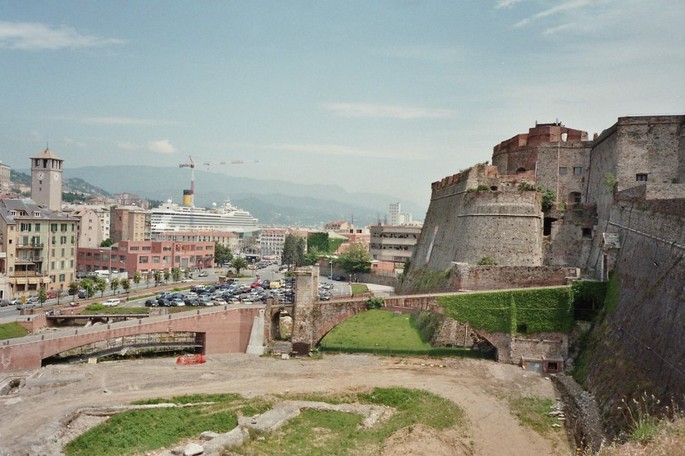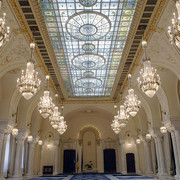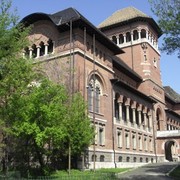It was built in 1542 on a promontory (where already in the Middle Ages there was the heart of the town of Savona) by engineer Giovanni Maria Olgiati by the then Republic of Genoa when it had control of the city after the abolishment of the free commune and needed to set up points of defense against possible attacks from the sea.
In the seventeenth century it was equipped with ramparts designed by the engineer of the King of Spain Domenico Sirena. In the eighteenth century they were built the palaces of the Commissioner and the officers and that of the Sibyl. In 1746 a gap was opened by the grenadiers of Savoy in the curtain of the Angel. In 1820 it became a penitentiary.
Signs of life during antiquity in the area surrounding the so-called fortress Priamar are inferable from the remains of pre-Roman, Roman and Byzantine emerged from excavations made during the centuries around the fort and now preserved in the Archaeological Museum. The Priamàr fortress is also known since, transformed into military penitentiary, was prison - in full Risorgimento - for Giuseppe Mazzini, whose cell can still be visited.
After the establishment of the free commune, the cape became the center of the medieval city. There stood the town halls, the Bishop's Palace and the ancient cathedral (destroyed in 1595 to make way for housing the commissioner of the Citadel in the new fortress), built between the years 825 and 887 on remains of a former pagan temple. She was named first Santa Maria Maggiore, then St. Maria di Castello.
According to the description of the historian Giordano, the churchyard of this temple had a marble floor black and white checkered and atop eight steps were the three main entrances to the church.
The floor inside was equal to the square, the side chapels richly decorated with inlay and marble statues (part of which preserved in the cloister of the new cathedral).
The apse, decorated with viable loggias, was overlooking the sea and it was enjoying a unique panorama facing the entire Ligurian Riviera. There were also a bell tower and a baptistery.
The facade was typically Romanesque, probably gabled and decorated in marble black and white horizontal bands.
But the real treasure of the cathedral was the choir with wooden inlay, inspired by those of the Certosa di Pavia and the Basilica of St. Francis in Assisi. It was saved from destruction and rebuilt in the apse of the new cathedral of Savona adapting its circular shape to a new square apse. The chorus, recently restored, is of great value.
But all that was the structure of the ancient cathedral - which according to some local historians was at that time one of the most beautiful in the Mediterranean Sea - has been completely lost. Even today the walls still existing and abandoned near the top of the fortress are a worry for Savona at the thought that their fellow citizens of the Middle Ages saw the overthrow of their cathedral and remained for many years without a church that would replace definitively.
As a partial consolation is the fact that all is not lost: many sculptures and works of the old cathedral are preserved in Savona's museums and in the new cathedral. In recent years there has been a major restoration of the fortress, previously abandoned, with a reopening of the excavations and cultural events linked to them.
Today the fortress of Priamàr looks like a great edifice, which stands over the city with a single large access ramp and two main squares: the Piazzale del Maschio, enclosed in buildings and home to opera and theatrical events, and the square of the Sibyl where arise excavations of the cathedral and which offers spectacular views of the city and the sea. Besides these there are also a large number of buildings (the Palace of the Sibyl, the Captain's Palace, The Palace of the Commissioner, and others), roads, public gardens, ramparts and tunnels, many of which are still secret or impractical (one of them led from the top of the fortress to the port).
Since 2001 the city of Savona, upon request, agrees to hold civil weddings in two of the rooms of the fortress.
[Read also our last week's article about the Archaeological Museum].






















![Hanbury Gardens, itineraries for everyone all year round [Videos] Hanbury Gardens, itineraries for everyone all year round [Videos]](https://www.italyrivieralps.com/typo3temp/pics/g_a7708c6a79.jpg)





